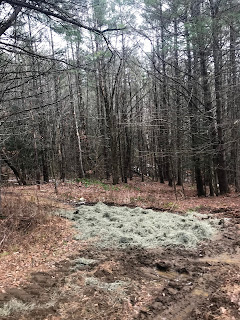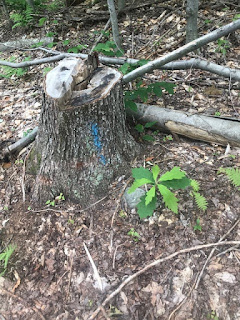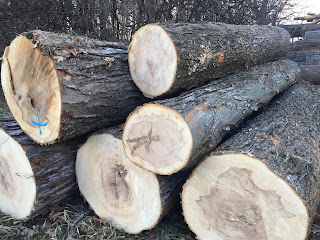ACF Update 12/14/20 -- Trail "Resilience" and Restoration
So, while we're still waiting for the ground to freeze up at the Andrews Community Forest, we've found ways to keep busy. Tim Brown has been processing firewood on the log landing, and skidding some wood to the landing on cold mornings. We've also shipped one load of white pine logs to Lamell Lumber in Essex.
Our main activity has been thinking about and dealing with one problematic section of trail. It came to our attention this fall that this portion of our main trail between the woods and the log landing (which we've discussed on this blog previously) was less dry, less well-drained, and less stable than we thought when we were planning this project. We have tried many different things to get around this section of trail -- using several different potential routes -- but in each case the soils have, for the most part, just been too wet to use this section of trail in a responsible way while they are unfrozen.
As we've discussed in previous blog entries, while some sections of this trail are muddy, we've worked hard to avoid erosion, siltation and root damage. While seeing mud and wheel ruts can be jarring, the main reason we want to avoid them is to avoid polluting our waterways, negatively impacting aquatic organisms, destabilizing and damaging trail systems for future use, and causing root damage to adjacent trees. None of these things have occurred at the Andrews Community Forest, although if we were trying to use these trails heavily right now, they could.
One of the attributes that we want to manage forests for in a changing climate is resilience. Resilience is the ability of an ecosystem to stay healthy amidst great change and stress, such as we expect them to increasingly encounter in a changing climate. In a forest management context, this means dealing with threats to forest health, increasing forest diversity and complexity, keeping forests intact and forested and more. It can also mean protecting our ability to access our forests (our roads, trails and landings) by buffering them from the effects of climate change, from precipitation events of increased frequency and severity to increasingly mild winters. It may mean building trails not for the weather and conditions we have now, but the weather and conditions we expect to encounter in the future.
The work that we're doing at Andrews has value not just for education and demonstration -- the goal of this work is also to proactively make the forest healthier and more diverse, with great wildlife habitat. The resources we're producing are also something we can be proud of -- see a recent video on that subject here. We want to make sure that even if we have a mild winter now or in the future that we can get this work done without compromising our values or critcal resources like clean water.
With this in mind, our long-term goal is to vastly improve the durability and resilience of this section of trail, both for forestry and for recreational usage, in the short and long-term. We have an application into Richmond's Conservation Reserve Fund to do ditching, improve stream crossings, install better drainage and to add road fabric and gravel to a couple sections of trails. This project meets the goals of the CRF by seeking to protect water quality and aquatic habitat, improve access to the Community Forest and to support traditional land uses and the working landscape. Unfortunately, with winter coming fast timing wasn't on our side, and so by the time the CRF funding has been approved we will likely have to look to complete the project next summer (2021).
In the short term, we wanted to see if we could improve the trail system just enough to get through this winter at no cost to the town. We were blessed with lots of generosity, especially from Jeff Hutchins and J Hutchins Inc., who donated the use of an excavator for the weekend. Big thanks are also due to Pete Gosselin and the Richmond Highway Dept., who donated culverts for the project and delivered them to the site, and to Tim Brown, the logger we're working with at Andrews, who donated his time running that excavator. Please, if you see these folks around town thank them for their generosity on behalf of our community.
On Saturday, December 12, we were able to install some new trail crossings with culverts -- some of which will be permanent and one of which will be removed upon completion of the forest management project -- establish and "clean-out" water bars, including digging some "sediment traps" at their outlets, improve drainage and trail shaping and to smooth out some muddy areas. We did this all at no cost to the Town.
We hope that this will be the first step in both completing the forest management project at Andrews smoothly (even if we have a mild winter) but also in taking a holistic approach towards improving the resilience of our access infrastructure at Andrews and across the region, with the expectation of more climatic challenges to come. We also hope that this project showcases our first attempt to partner with private companies to sponsor important work at Community Forests across the County, which is a great opportunity.
You can watch a short video on last weekend's work, here.





Comments
Post a Comment